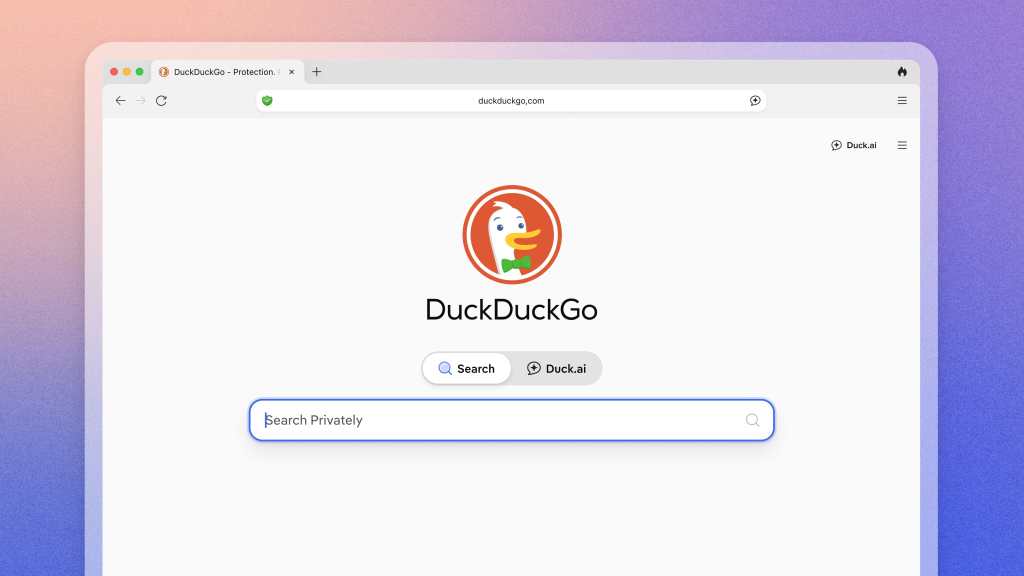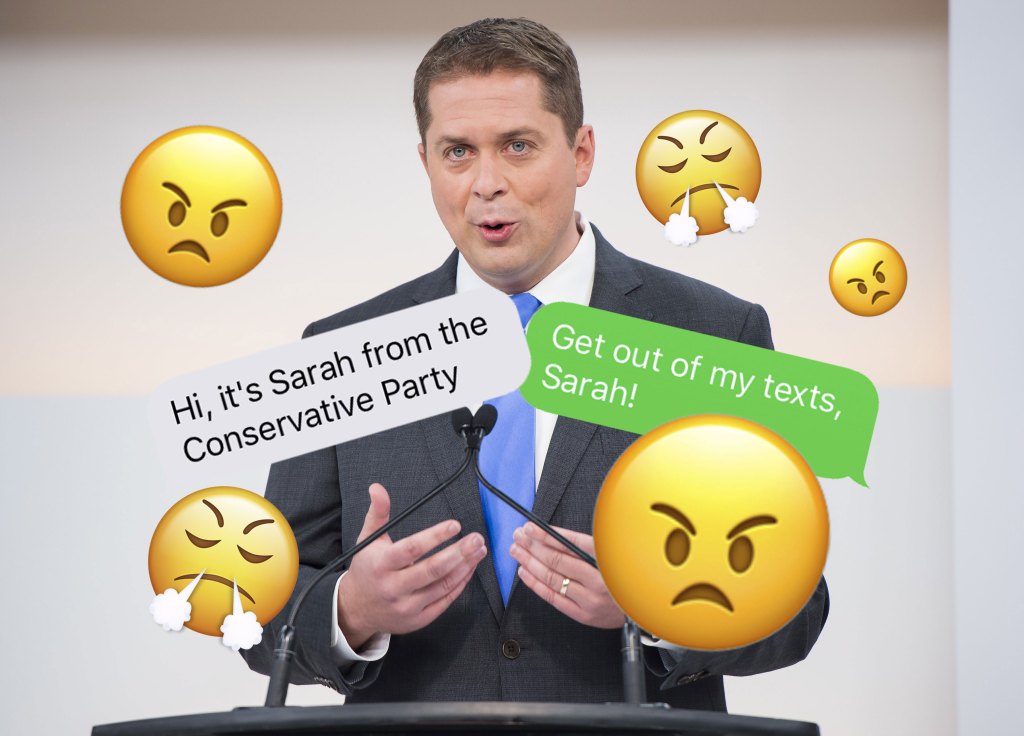If you’ve paid your cellphone bill in Canada in the past six months, you’ve no doubt received an unexpected text message from the Conservative Party soliciting your views on the upcoming election or the carbon tax.
“Hi, it’s Sarah from the Conservative Party,” a typical text begins. “Can the Conservative Party count on your support in the next federal election? Reply: Yes / No.”
Videos by VICE
No matter your political stripe, you’ve probably responded with some degree of profanity. Get out of my texts, Sarah!
Now that the election is afoot, expect to see these kind of tactics getting used by every political actor in the most cloying way imaginable.
But I wanted to find out who Sarah was, how she got my number, and just what the hell she was doing with my information. Let’s say I responded and said, “yo sarah wyd, let’s get rid of a price on carbon.” Is my opposition to sensible market solutions to address climate change going into an omniscient voter contact database somewhere?
Not really, as it turns out. Canada’s political parties aren’t yet sophisticated enough to do the kind of data mining necessary to make these text campaigns truly effective.
Parties in Canada all start from roughly the same point in terms of information about voters. Elections Canada sends out a giant file with the names, and addresses of every voter — parties can then go about getting their landlines from the phone companies. That database is mostly populated through tax returns, immigration information, provincial drivers’ licences, and some self-reporting.
Suffice it to say, these lists are a mess. Addresses are wrong, phone numbers are disconnected, voters are dead: There’s no shortage of headaches for these voter rolls. It’s why door-knocking remains the gold standard of voter outreach in Canadian elections. It’s pretty rare that you step up to an address and it has disappeared.
Cory Hann, spokesperson for the Conservative Party of Canada, admitted that Sarah wasn’t a real person, but generously offered to pick a random Sarah employee for VICE to speak with. “We do have a lot of Sarahs,” he said.
Hann laid out how his party goes about blowing up our phones. “The numbers we contact fall into one of two categories—they’re either numbers that Canadians have voluntarily provided us, or they’re randomly generated programmatically through the use of a software program,” he wrote in an email. “Some numbers will work, some will not, some will exist, some don’t at all.“
The party (or, more specifically, the private company the party hired to do this) can get the first six numbers, because that part of your phone number is administered by the very-modern sounding Canadian Numbering Administrator, but the parties need to randomly guess the next four digits—which means randomly texting a lot of confused people.
Given the database of voters is still very much stuck in 1996, at best, trying to tie voters to cell phone numbers is still the stuff of fantasy. Parties are seeing some return in getting supporters to subscribe to email updates and surrender some information that way—email addresses can, in turn, lead to Facebook pages—but the time and money involved in trying to beef up these Elections Canada-supplied lists remains far off.
That doesn’t mean these outreach campaigns aren’t effective. If 200,000 people respond, “Yes, I want to execute whales” to a party’s text message blast, the party can go about calling those people back and trying to elicit their information—their name, for one, but also an address.
That’s arduous, though. The party makes it pretty clear that Canadians who don’t appreciate the texts won’t be contacted again. Your “we stan carbon pricing!!!” text is probably sitting in a cell on a spreadsheet somewhere, forgotten, but we don’t know for sure. We asked what the party does with those responses, but they did not answer.
Even without that, having a list of cellphone numbers of probable supporters who won’t leave you on read gives you something to work with on election day, especially if you’re worried your supporters aren’t heading to the polls.
There is, of course, a risk with this strategy. Andrew Scheer and the Conservatives need Liberal voters to stay home. In 2015, Stephen Harper won nearly the same number of votes he had in 2011. Trouble is, he got buried under a pile of new, young voters coming out for the Liberal Party.
Texting everyone in the country and asking them to get angry about a price on carbon might motivate your base of tree-hating oil-suckers, but it also has the knock-on effect of motivating people who care about the climate to go out and vote.
Third Party Advertisers
If the parties are stuck in very analog ways of voter outreach, a new class of third party advertisers have descended on the Canadian electorate like crows to garbage. And they are playing the data analytics game with a lot more skill and deft than the Conservative Party.
These third parties range from bigger organizations such as Canada Proud, a conservative political action committee, and the United Steelworkers union, to more fly-by-night operations such as a group registered as “Shake Up The Establishment” or Clarence Shields, which is just a guy named Clarence Shields who registered himself as a third party for the purposes of the upcoming election.
Canada Proud—which also goes by a host of their provincial monikers, including Ontario Proud—is likely the most effective. Founder Jeff Ballingall, who still runs things, recently showed VICE the influx of small donations that’ve flowed into his organization’s coffers. (Yes, he also takes huge cheques from real estate developers and oil companies.)
His data game is a bit more nimble than the big parties. Because he doesn’t have access to the voter rolls put out by Elections Canada, he’s had to build up a list of Canadians to harangue all on his own. Ballingall says his organization has built up its substantial database “through petitions, surveys, donors, and digital media outreach.”
Because that database starts with voters’ social media platforms and emails, it makes it a more powerful outreach tool, not beholden to dispatching someone to their doorstep or hiring a person with a phone to call their phone, like some kind of caveman. Plugging in emails obtained through the surveys into Facebook, for example, allows Canada Proud to target ads specifically to that cohort. That group might already be of the ideological persuasion of Canada Proud, but so much of Ballingall’s strategy involves tapping supporters to boost and share his content to their friends, family, coworkers, etc.
While there remains some healthy skepticism as to just how effective microtargeting is for social media advertising, Ballingall says he makes a point of serving ads to people based on their interests—the pages they like, if they list themselves as a veteran, whether they’re retired, and so on.
Ballingall likes to point out that his Canada Proud page boasts significantly more engagement than the Globe and Mail, Toronto Star, and even Justin Trudeau’s own Facebook page.
For this campaign, Canada Proud will be pushing out right-wing memes designed to inspire centre-right voters to the polls for Scheer. The Elections Act, however, expressly forbids Ballingall, or a third-party advertiser, from working with any registered party. That also precludes, say, union giant Unifor from conspiring with the NDP to team up on voter targeting or advertising.
That puts a wall between the parties’ all-encompassing voter rolls and Ballingall’s more impressive voter targeting system. Unions and the NDP might say the same thing, but they can’t conspire to say the same thing to each others’ targeted voters or supporters.
But once we’re outside of an election period, there isn’t a whole lot Elections Canada can do about these third parties. It means groups like Canada Proud or Unifor could act very much as contractors or guns-for-hire for the parties or specific candidates.
While Ballingall insists he would never fork over his lists to another party, others might not be so scrupulous. The activities of political parties are, generally, exempt from Canada’s privacy laws. And even if he’s not selling or trading data, the Conservative Party would have a lot of incentive to get in the same room as Canada Proud—or the NDP with the unions, or the Liberals and whatever shady group they want to work with. This has been the reality in the U.S. for years, where political action committees have traded and sold voter data to campaigns. There is, after all, value in information.
That problem hasn’t quite hit Canada. Tory leadership candidate Brad Trost had been accused of leaking the party membership to a gun lobby group, ostensibly in hopes the gun nuts would use that information to sign up their members for Trost. The allegations were later dropped for lack of evidence.
Third parties also faces no rules on their financing or spending outside an election. With the wild proliferation of these groups, there’s no telling how each will behave. The more information they collect on voters, supporters, and donors, the more they find themselves attractive partners for political operators—by selling or giving data to political parties or by using it to their own ends.
Look no further than Ontario Strong (no affiliation with Ontario Proud), who borrowed Sarah’s tactics, sending out a text message blast to, potentially, millions, reading: “Hi, this is Sue from Ontario Strong. Do you agree that we must scrap the Carbon Tax? Respond: Yes / No.”
That organization remains mysterious, and hasn’t yet registered with Elections Canada—and may never do so. There’s no telling what they could do with the information they collected from that text message blast.
Or whether Sue knows Sarah.
Follow Justin Ling on Twitter.
Correction: An earlier version of this story says Elections Canada sends out phone numbers, along with voters’ names. It only sends out addresses.
More
From VICE
-

Photo: drante / Getty Images -

Photo: dbvirago / Getty Images -

Credit: DuckDuckGo -

Photo: Oleg Breslavtsev / Getty Images
